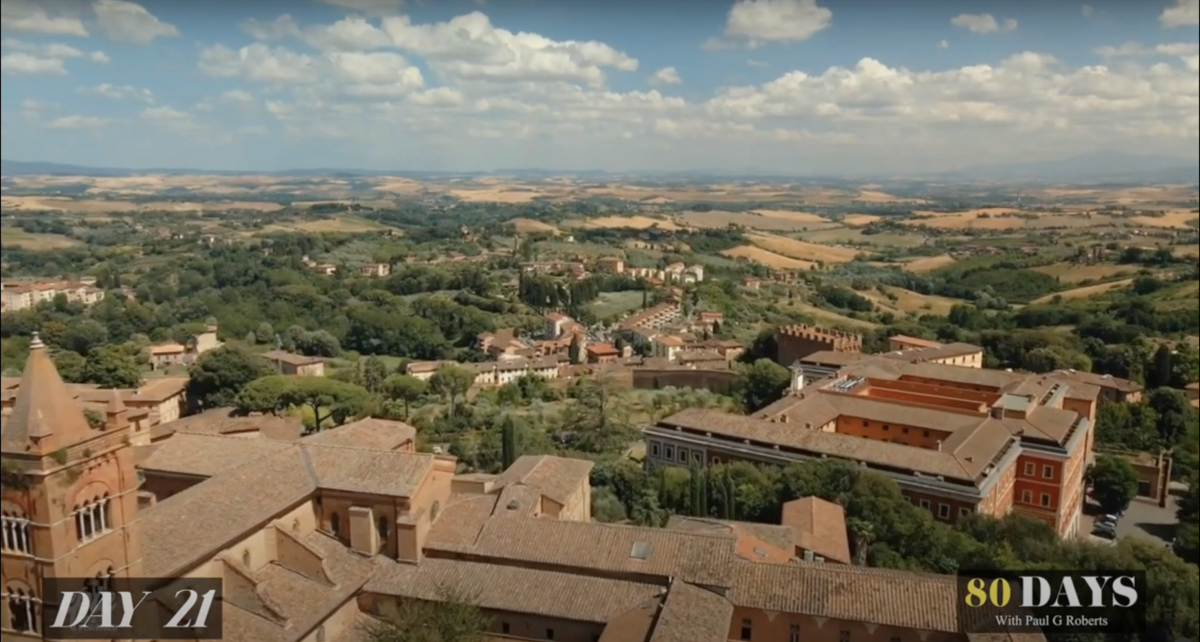First up, it’s Day 20 and Roberts is hopping aboard the fabulous Frecciarossa High speed train from Siena to Rome. Next, Roberts gives an insight into the history of Rome.

For the journey from Siena to Rome going by train is your best bet, considering Siena’s restricted parking, and Rome’s hectic driving conditions. The train makes it easy to cover the 145 miles (233 km) by train, though it’s not a direct route. It may seem, but this is a case where the slower trains actually make the trip more quickly than the high-speed trains.
There are 36 Trenitalia trains departing Siena each day that will get you to Roma Termini train station, some of which are the high-speed Alta Velocità (AV) trains. The rest are Regionale or InterCity trains, which aren’t quite as fast and make more stops along the way. There are no direct trains from Siena to Rome, so you’ll need to change trains at some point along the way, usually in Florence.
You will take a Regionale a Regionale train from Siena to Florence, and then an AV train from Florence to Rome. Your other option is to take a Regionale train from Siena to Chiusi-Chianciano Terme, and then another Regionale train from Chiusi to Rome. Ticket prices range from $22-46. Once you get to Firenze Santa Maria Novella, you can also take an Italo train to Roma Termini or Roma Tiburtina. The Trenitalia Regionale train from Siena to Florence takes about 1.5 hours, and then the Italo train from Florence to Rome takes about another 1.5 hours.
DAY 21 – HISTORY OF ROME
From law and politics to architecture and civil engineering, from literature and the arts to the very languages we speak, the Roman Empire’s echoes continue to be heard. The mythical origins of Rome’s foundation begin in the Latin city of Alba Longa.
There, the twin newborn sons of the war god, Mars, and a priestess were sentenced to death by their great-uncle. Romulus and Remus were famously saved by a she-wolf and raised by a poor shepherd. As young men, they set out to establish their own city, but Remus was murdered by his brother in a dispute over its location. As king, Romulus declared Rome an “asylum city,” which very quickly attracted unsavoury characters from across the Italian peninsula.
Wives were needed for this mostly male population, so young women were abducted from neighbouring cities and tribes, in an act immortalised as the “rape of the Sabine women.” Despite this, within a matter of years, Romulus and the king of the Sabines arranged to co-rule. Roman Kings What happened next would be repeated throughout Rome’s history: the mysterious or violent death of the ruler. First, it was the Sabine king, Titus Tatius, who died during a riot.
Then, Romulus disappeared during a storm. In the myth, he became the god Quirinus and left this earthly realm. He was likely killed by political rivals. During the reign of the second king, Numa Pompilius, key Roman elements appeared, including the twelve-month calendar, the Vestal Virgins, and the position of Pontifex or priest. Numa was followed by five other kings, the last of whom, nicknamed Tarquin the Proud, not only murdered his predecessor but was overthrown by the people. Thus was the ‘free Republic of Rome’ born in the sixth century BCE.
Subscribe to FIB’s Weekly Breaking News Report for your weekly dose of music, fashion and pop culture news!






